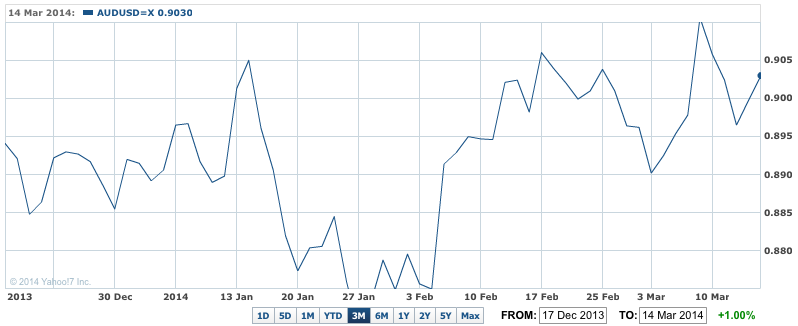If you had to pick the oddest event in the markets last week, so far as Australia is concerned, it was the continuing strength of the dollar.
The normally China-sensitive Aussie held up well, helped by a combination of Thursday’s strong February jobs data in Australia, a belief the Chinese economic picture is not as weak as it currently appears, and the currency’s continuing role as a small haven of safety for big investors.
The currency ended at 90.30 in US trading on the weekend after trading through a narrow range of 89.97 to 90.50 USc during the trading day in Asia, Europe and the US.
For the currency of the economy most leveraged to China – and after last week’s fears about copper, credit, iron ore, as well as Crimea, the Aussie held up remarkably well.
The move by the Reserve Bank of New Zealand to become the first developed country to raise interest rates (by 0.25% to 2.75%) only briefly impacted the Aussie currency on Thursday before the impact of the local jobs report was felt and the currency jumped back above 90 USc.
NZ rates have been lower for longer than in Australia and its economic recovery is far more advanced.
The AMP’s chief economist, Dr Shane Oliver says he expects the dollar to continue to ease in coming months.
"The broad trend in the $A remains down on the back of softer commodity prices, a reversion to levels that offset Australia’s high cost base and a decline in Australia’s growth relative to that in the US," he wrote at the weekend.
Overall, the Aussie dollar was down a few basis points from the week before.
AUDUSD 3-Month – Aussie dollar defies predictions

But it was a different story for the world’s major stockmarkets though.
Over the week US shares fell 2% to 3%, Eurozone shares fell 3.3%, Japanese shares fell 6.2%, Chinese shares fell 2.6% and Australian shares fell 2.4%.
On Wall Street, the Dow fell 43.22 points or 0.3%, to 16,065.67, the S&P 500 lost 5.21 points or 0.3%, to 1,841.13 and the Nasdaq Composite dropped 15.023 points or 0.4%, to 4,245.396.
For the week, the Dow fell 2.35%, the S&P dropped 1.97% and the Nasdaq lost 2.1% .
In Europe, the Stoxx Europe 600 index dropped 0.7% to 322.23, a loss of 3.3% for the week, the biggest weekly loss since last June.
France’s CAC 40 index closed the session on Friday down 0.8% at 4,216.37. It lost 3.5% on a weekly basis, the sharpest drop since late January.
London’s FTSE 100 fell 0.4% to 6,527.89, for a weekly decline of 2.8%.
But Germany’s DAX 30 index on Friday turned 0.4% higher to settle at 9,056.4. That was down 3.2% for the week.
In Asia, the MSCI Asia Pacific Index fell 3.5%, the largest one-week decline in almost two years, to 134.32, thanks to the speculation China would miss its 7.5% economic growth target for 2014.
Hong Kong’s Hang Seng Index dropped 4.9%, the biggest weekly decline since May 2012. The Shanghai Composite Index lost 2.6%.
The Nikkei’s 6.2% fall was linked to a move by the Bank of Japan to cut the amount of long term bonds it is currently buying as part of its quantitative easing.
South Korea’s Kospi Index fell 0.3% and New Zealand’s NZX 50 Index slid almost 1%.
In Australia, the ASX200 Index lost 132.9 points, or 2.4%, to finish at 5329.4.
The All Ordinaries Index fell 129.2 points, or 2.4% to 5347.1.
Friday’s fall of 1.5% marked the indices’ worst sessions in more than a month.
The contrast between the strength of support for the dollar and the weakness in sentiment in the sharemarket was telling.













